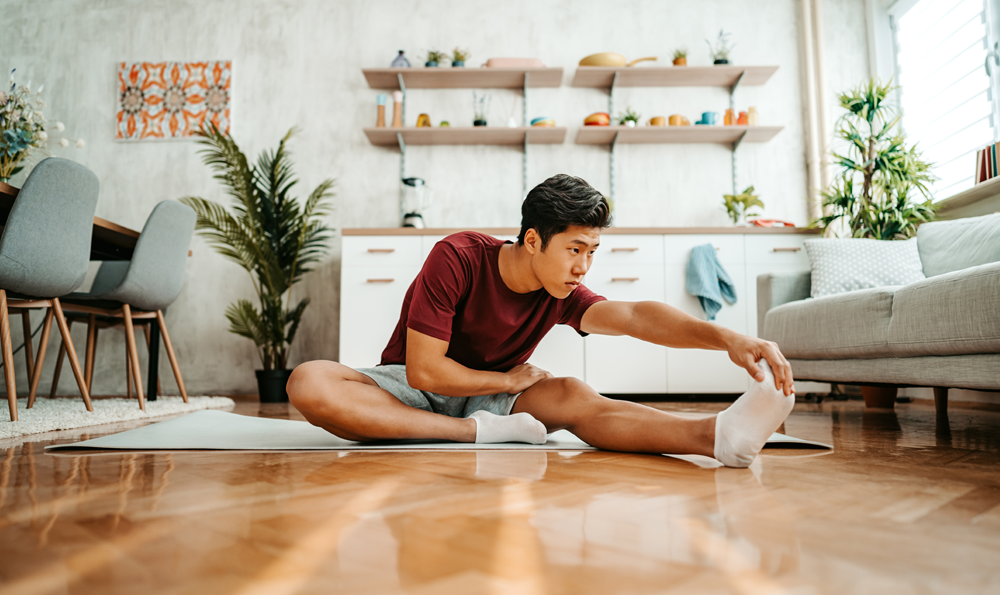Of all types of exercise, stretching is probably the most overlooked. This is especially true if you aren’t in pain or experiencing muscle tightness. However, a few simple daily stretches can help prevent injury, preserve your flexibility and improve your mobility.
“Across the spectrum, people are just not committed to stretching on a regular basis,” says Shannon White, physical therapist at Atlantic Health. “Stretching is absolutely a part of the recovery, strength building and rehabilitation process, but it can also help maintain your range of motion and prevent pain.”
The benefits of stretching
When we stretch, we lengthen our muscles and ligaments, which helps keep our joints and connective tissue flexible. Taking a few moments to stretch before and after a workout or other strenuous activity can reduce your risk of injury, as well as prevent muscle aches and joint pain.
“When you skip stretching, you’ll feel the results across your musculoskeletal system,” says White. “Some muscles will stay tight, others will feel weak. This can lead to pain and discomfort, which many people think is a normal part of life or aging and it’s not. It’s your body trying to tell you something is off and needs to be addressed.”
Types of stretches
There are two general types of stretches: static and dynamic. Static stretches typically involve holding a single position for 20 to 30 seconds, while dynamic stretches involve movements, such as yoga poses or tai chi positions. One isn’t necessarily better than the other and White suggests trying different types of both to decide what feels best to you.
Like so many healthy habits, the key to stretching is consistency. Because it takes time to see results from stretching, White says many people give up after a short time. She explains that stretching is an excellent way to manage structural changes to your body, as well as injuries. Taking just five to 10 minutes a few times a week to stretch can have a big impact. In addition to the physical benefits, White says that regular stretching can lower your stress hormones, helping to boost your mind-body connection.
Do these stretches to improve and maintain your flexibility
White stresses that stretching shouldn’t hurt. If you feel pain when doing any of the stretches outlined below, it’s a signal you need to stop and modify your position or how far you are stretching to find a comfortable position. You shouldn’t push too hard when stretching since that’s often counterproductive. It’s best to ease into your stretch until you feel some restriction and then hang out in that place for a few moments while taking slow, deep breaths.
Doorway pec stretch at 60 elevation: Begin this stretch standing upright in the center of a doorway. With your elbows bent, place your hand on the sides of the doorway at roughly a 60-degree angle from your sides, then take a small step forward until you feel a stretch in the front of your shoulders. Hold this position for 30 to 60 seconds and repeat up to three times. Make sure to maintain a gentle stretch and do not shrug your shoulders during the exercise.
Side lying open book thoracic lumbar rotation and extension: Begin lying on your side with your bottom leg straight, your top leg bent at a 90-degree angle and your arms straight on the ground together. Slowly move your top arm away from your other arm, toward the floor on the other side, rotating your trunk at the same time. Hold for five seconds. Make sure to keep your top leg on the floor and only go as far as you can without arching your back. Repeat the movement 10 times.
Supine quadriceps stretch on a table with a strap: Begin lying on your back on a bed with one leg hanging off the edge, holding the end of a strap that is draped over your shoulder and secured around your foot. Slowly pull on the strap, bending your knee until you feel a stretch in the front of your thigh. Hold this position for 30 to 60 seconds. Make sure not to arch your lower back during the stretch. If you do not have a firm strap, you can use a towel or just perform the movement actively without a strap. Repeat three times.
Supine figure 4 piriformis stretch: Begin by lying on your back with your knees bent. Cross one leg over the other so your ankle is resting on your opposite knee. Pull your leg towards your chest until you feel a stretch and hold for 30 to 60 seconds. Make sure to keep your back flat against the bed during the stretch. Repeat three times.
Gastroc stretch on wall: Begin standing upright in front of a wall. Place your hands on the wall and extend one leg straight backward, bending your front leg, until you feel a stretch in the calf of your back leg and hold for 30 to 60 seconds. Make sure to keep your heels on the ground and back knee straight during the stretch. Repeat three times.












